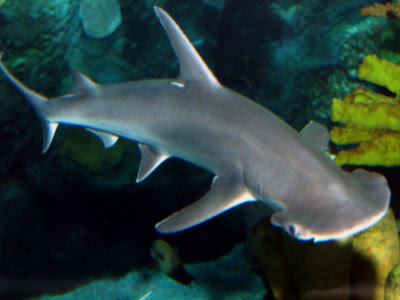Animal Unique | Bonnethead Shark | The Bonnethead shark is the smallest member of the hammerhead, the family is characterized by having the eyes situated at the ends of the extended lateral lobes. The Greek word Sphyrna translates as hammer, referring to the shape of the head of this shark's - tiburo is the Taino word for shark. The Bonnethead shark is very distinctive in appearance because it has a smooth, wide extended main, often described as "spade-shaped," with more curve to do it over the heads of other hammerhead sharks. Also, the front of the head lacks a median groove, which is present in other hammerheads. These fish are in the western Atlantic Ocean from North Carolina (occasionally Rhode Island) to the south of Brazil, but also around Cuba and the Bahamas, and in the eastern Pacific from southern California to ecuador.
Scientific classification
Kingdom: Animalia
Phylum: Chordata
Class: Chondrichthyes
Subclass: Elasmobranchii
Order: Carcharhiniformes
Family: Sphyrnidae
Genus: Sphyrna
Species: S. tiburo
Kingdom: Animalia
Phylum: Chordata
Class: Chondrichthyes
Subclass: Elasmobranchii
Order: Carcharhiniformes
Family: Sphyrnidae
Genus: Sphyrna
Species: S. tiburo
Characterized by a broad, smooth, spade-like head, they have the smallest Hammerhead sharks of all Sphyrna. Gray-brown above and lighter on the bottom, it is a timid and harmless sharks. The Bonnethead shark is an active tropical shark that swims in small groups of 5 to 15 people. Strangely, though, the schools of hundreds or even thousands reported. Bonnethead sharks move constantly following changes in water temperature and respiration maintained. The Bonnethead shark will sink if it does not keep moving, because hammerhead sharks are among the most negative buoyancy of marine vertebrates.
Gray to gray-brown in color, the bonnet head shark is rarely higher than 3 meters in length, maturing at about this length to contribute 6 to 12 live young at a time. Bonnethead sharks, especially juveniles, often more than flats, where they can be taken on fly and ultra light tackle. It feeds mainly on crustaceans, mostly consisting of blue crabs, but also shrimp, mollusks and small fish. Seagrasses are found in the stomach contents. To accommodate the many species of animals that feed it, the bonnet head shark has small, sharp teeth on the front of the mouth (for grabbing soft prey) and flat, wide choice in the back (for crushing hard-shelled prey).
The reasons for Hammerhead sharks scientific debate has caused more than a decade. Whatever the ultimate goal, a wing-shaped leaves cephalofoil hammerhead sharks swimming in a horizontal plane and was thought to allow them to perform sharp turns. However, research shows that the vortices that help them perform sharp bends. The t Hammerhead sharksl is responsible for enhanced electroreception and increased olfactory acuity.
The pectoral fins of most fish control throw (up-and-down movement of the body), yaw (side-to-side motion) and rolling. Most Hammerhead sharks do not roll or yaw and pitch to achieve using their cephalofoil. The smaller of a Bonnethead shark is not as successful, and they therefore have to rely on the combination of their large pectoral fins and cephalofoil for most of their mobility. Compared with other Hammerhead sharks, Bonnethead shark have larger and more developed pectoral fins and are the only kind of hammer to actively use flippers for swimming.
Animal Unique





Tidak ada komentar:
Posting Komentar